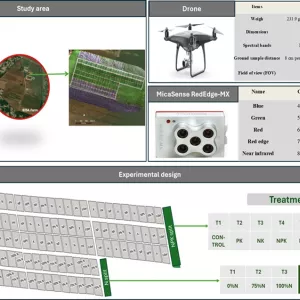From Sky to Soil: How Drones are Revolutionizing Crop Monitoring
by Tanu Kumari, Kranthi Kumar Challa, Shweta, Amit Kumar Srivastava In a world where food demand is soaring, yet arable land is shrinking, technology is redefining how we monitor and manage crops. One of the most promising innovations in precision agriculture is the use of drones—Unmanned Aerial Vehicles (UAVs)—to detect crop stress and predict yields with enhanced accuracy. Unpredictable Crop

From Sky to Soil: How Drones are Revolutionizing Crop Monitoring
by Tanu Kumari, Kranthi Kumar Challa, Shweta, Amit Kumar Srivastava
In a world where food demand is soaring, yet arable land is shrinking, technology is redefining how we monitor and manage crops. One of the most promising innovations in precision agriculture is the use of drones—Unmanned Aerial Vehicles (UAVs)—to detect crop stress and predict yields with enhanced accuracy.
Unpredictable Crop Stress
Agriculture is increasingly challenged by abiotic stressors like water scarcity, nutrient deficiencies, and extreme climate events, which account for nearly 50% of global crop yield losses. In India, where rice and wheat form the backbone of food security, farmers rely heavily on traditional labor-intensive monitoring methods, which are often inadequate for large-scale farming. Satellite imagery, while useful, frequently lacks the resolution needed for early stress detection. This is where UAV-based remote sensing steps in as a game-changer.
Drones and Data: A Precision Approach to Farming
Drones equipped with multispectral, hyperspectral, and thermal sensors offer high-resolution, real-time data for crop health monitoring. These aerial tools capture data on plant stress indicators—such as canopy temperature, chlorophyll levels, and soil moisture—long before symptoms become visible to the naked eye. Farmers can optimize fertilizer use, irrigation schedules, and pest management by integrating this information with machine learning models, leading to healthier crops and improved yields.
Bringing Innovation to the Fields of Bihar
A recent study conducted at the Borlaug Institute for South Asia (BISA) in Bihar, in collaboration with the International Rice Research Institute (IRRI), tested the effectiveness of UAV technology for stress mapping and yield prediction in rice and wheat, which is a dominant cropping system in the Indo-Gangetic Plains of India. The study, spanning two years (2022-2024) and four cropping seasons, examined how different fertilizer treatments and irrigation strategies impacted crop health.
The experiment divided fields into two sections: one focused on the impact of Nitrogen-Phosphorous-Potassium (NPK) fertilizers, while the other analyzed nitrogen-split applications under various water conditions. Using a combination of UAV imagery and field-based measurements—including Normalized Difference Water Index (NDWI) for water stress and Soil Plant Analysis Development (SPAD) values for nitrogen levels—the research team could precisely map stress patterns throughout the crop cycle.

